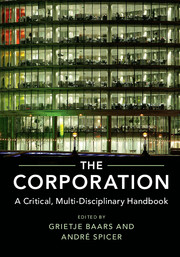Book contents
- Frontmatter
- Contents
- List of Contributors
- Acknowledgements
- Introduction: Why the Corporation?
- PART I DISCIPLINARY OVERVIEWS
- PART II INTERDISCIPLINARY THEMATIC CHAPTERS
- 1 The Evolution of the Corporate Form
- 2 The Multinational Corporate Group
- 3 The Financialization of the Corporation
- 4 Corporate Value Chains
- 5 Corporate Citizenship
- 6 The Corporation and Crime
- a The Criminal Corporate Person
- b The FBI on Corporate Crime: Examining the Influence of Corporate Culture
- c Mental Blockades in the Recognition of Mens Rea in Corporations
- 7 The Corporation and Ideology
- 8 Corporation and Communities
- 9 Corporations and Resistance
- 10 Alternatives to the Corporation
- Index
- References
b - The FBI on Corporate Crime: Examining the Influence of Corporate Culture
from 6 - The Corporation and Crime
Published online by Cambridge University Press: 31 March 2017
- Frontmatter
- Contents
- List of Contributors
- Acknowledgements
- Introduction: Why the Corporation?
- PART I DISCIPLINARY OVERVIEWS
- PART II INTERDISCIPLINARY THEMATIC CHAPTERS
- 1 The Evolution of the Corporate Form
- 2 The Multinational Corporate Group
- 3 The Financialization of the Corporation
- 4 Corporate Value Chains
- 5 Corporate Citizenship
- 6 The Corporation and Crime
- a The Criminal Corporate Person
- b The FBI on Corporate Crime: Examining the Influence of Corporate Culture
- c Mental Blockades in the Recognition of Mens Rea in Corporations
- 7 The Corporation and Ideology
- 8 Corporation and Communities
- 9 Corporations and Resistance
- 10 Alternatives to the Corporation
- Index
- References
Summary
James Comey, director of the Federal Bureau of Investigation (FBI) and former United States deputy attorney general, reflected on a question that he frequently hears: ‘How come we haven't seen more high-level financial execs brought to justice?’ Comey used this question to prompt his 2014 keynote address at the New York City Bar White Collar Crime Institute (Comey, 2014). According to Comey, the great challenge in corporate crime cases lies in three sources of complexity: First is the distinction between the corporation, as a legal construct, and individuals inside corporations who engage in criminal activity. Second, prosecutors must not only demonstrate that a criminal act took place (i.e., the actus reus requirement) but also demonstrate that a corporate offender had the mental intent to commit the crime (i.e., the mens rea requirement). Third, and most important, prosecutors must prove criminal mental intent ‘beyond a reasonable doubt’. Comey explains that ‘unlike a drug case – which is about connecting people to a transaction – in nearly every white-collar case, it is clear who was involved in the transactions’. So the real dilemma in corporate crime cases is that the FBI must uncover not only what acts took place, but also what these white-collar professionals were thinking when they enacted them. As Comey puts it, ‘We have to examine the contents of someone's mind.’
Rather than provide the audience with a deeper discussion of and challenges to the mens rea requirement in corporate criminal liability (cf. van der Wilt, this volume; Whyte, this volume; Wells, 2001; Baars, 2012; Almond, 2013), he instead told the audience:
Stupidity is not a crime. Risky behavior isn't a crime, no matter how many innocent people got hurt by that stupidity, greed, or recklessness. In this country, we put people in jail when we prove they knew that they were doing something criminally wrong.
(Comey, 2014)- Type
- Chapter
- Information
- The CorporationA Critical, Multi-Disciplinary Handbook, pp. 392 - 398Publisher: Cambridge University PressPrint publication year: 2017



